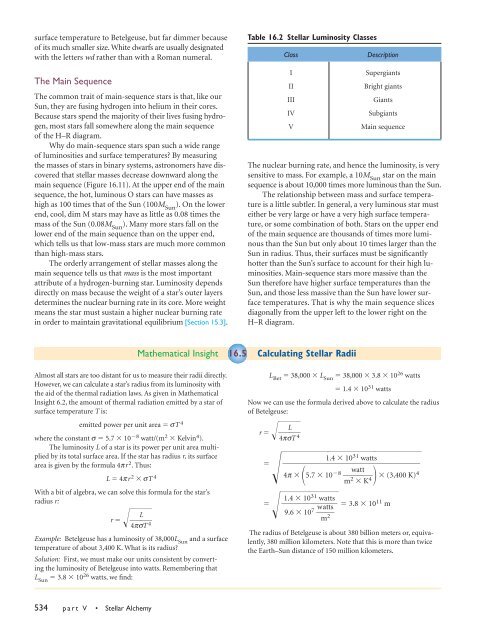Chapter 16--Properties of Stars
Chapter 16--Properties of Stars
Chapter 16--Properties of Stars
Create successful ePaper yourself
Turn your PDF publications into a flip-book with our unique Google optimized e-Paper software.
surface temperature to Betelgeuse, but far dimmer because<br />
<strong>of</strong> its much smaller size. White dwarfs are usually designated<br />
with the letters wd rather than with a Roman numeral.<br />
The Main Sequence<br />
The common trait <strong>of</strong> main-sequence stars is that, like our<br />
Sun, they are fusing hydrogen into helium in their cores.<br />
Because stars spend the majority <strong>of</strong> their lives fusing hydrogen,<br />
most stars fall somewhere along the main sequence<br />
<strong>of</strong> the H–R diagram.<br />
Why do main-sequence stars span such a wide range<br />
<strong>of</strong> luminosities and surface temperatures? By measuring<br />
the masses <strong>of</strong> stars in binary systems, astronomers have discovered<br />
that stellar masses decrease downward along the<br />
main sequence (Figure <strong>16</strong>.11). At the upper end <strong>of</strong> the main<br />
sequence, the hot, luminous O stars can have masses as<br />
high as 100 times that <strong>of</strong> the Sun (100M Sun ). On the lower<br />
end, cool, dim M stars may have as little as 0.08 times the<br />
mass <strong>of</strong> the Sun (0.08M Sun ). Many more stars fall on the<br />
lower end <strong>of</strong> the main sequence than on the upper end,<br />
which tells us that low-mass stars are much more common<br />
than high-mass stars.<br />
The orderly arrangement <strong>of</strong> stellar masses along the<br />
main sequence tells us that mass is the most important<br />
attribute <strong>of</strong> a hydrogen-burning star. Luminosity depends<br />
directly on mass because the weight <strong>of</strong> a star’s outer layers<br />
determines the nuclear burning rate in its core. More weight<br />
means the star must sustain a higher nuclear burning rate<br />
in order to maintain gravitational equilibrium [Section 15.3].<br />
Almost all stars are too distant for us to measure their radii directly.<br />
However, we can calculate a star’s radius from its luminosity with<br />
the aid <strong>of</strong> the thermal radiation laws. As given in Mathematical<br />
Insight 6.2, the amount <strong>of</strong> thermal radiation emitted by a star <strong>of</strong><br />
surface temperature T is:<br />
emitted power per unit area sT 4<br />
where the constant s 5.7 108 watt/(m2 Kelvin 4 ).<br />
The luminosity L <strong>of</strong> a star is its power per unit area multiplied<br />
by its total surface area. If the star has radius r, its surface<br />
area is given by the formula 4pr 2 .Thus:<br />
L 4pr 2 sT 4<br />
With a bit <strong>of</strong> algebra, we can solve this formula for the star’s<br />
radius r:<br />
r L<br />
4 4psT<br />
<br />
Example: Betelgeuse has a luminosity <strong>of</strong> 38,000LSun and a surface<br />
temperature <strong>of</strong> about 3,400 K. What is its radius?<br />
Solution: First, we must make our units consistent by converting<br />
the luminosity <strong>of</strong> Betelgeuse into watts. Remembering that<br />
LSun 3.8 1026 watts, we find:<br />
534 part V • Stellar Alchemy<br />
Table <strong>16</strong>.2 Stellar Luminosity Classes<br />
Class Description<br />
I Supergiants<br />
II Bright giants<br />
III Giants<br />
IV Subgiants<br />
V Main sequence<br />
The nuclear burning rate, and hence the luminosity, is very<br />
sensitive to mass. For example, a 10M Sun star on the main<br />
sequence is about 10,000 times more luminous than the Sun.<br />
The relationship between mass and surface temperature<br />
is a little subtler. In general, a very luminous star must<br />
either be very large or have a very high surface temperature,<br />
or some combination <strong>of</strong> both. <strong>Stars</strong> on the upper end<br />
<strong>of</strong> the main sequence are thousands <strong>of</strong> times more luminous<br />
than the Sun but only about 10 times larger than the<br />
Sun in radius. Thus, their surfaces must be significantly<br />
hotter than the Sun’s surface to account for their high luminosities.<br />
Main-sequence stars more massive than the<br />
Sun therefore have higher surface temperatures than the<br />
Sun, and those less massive than the Sun have lower surface<br />
temperatures. That is why the main sequence slices<br />
diagonally from the upper left to the lower right on the<br />
H–R diagram.<br />
Mathematical Insight <strong>16</strong>.5 Calculating Stellar Radii<br />
LBet 38,000 LSun 38,000 3.8 1026 watts<br />
1.4 1031 watts<br />
Now we can use the formula derived above to calculate the radius<br />
<strong>of</strong> Betelgeuse:<br />
<br />
r L<br />
4psT<br />
<br />
4<br />
1.4 1031 watts<br />
<br />
4p 5.7 108 watt<br />
<br />
m2 (3,400 K)4<br />
3.8 1011 1.4 10<br />
m<br />
31 watts<br />
<br />
9.6 107 watts<br />
<br />
m2<br />
The radius <strong>of</strong> Betelgeuse is about 380 billion meters or, equivalently,<br />
380 million kilometers. Note that this is more than twice<br />
the Earth–Sun distance <strong>of</strong> 150 million kilometers.<br />
<br />
K 4
















